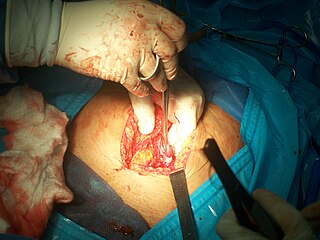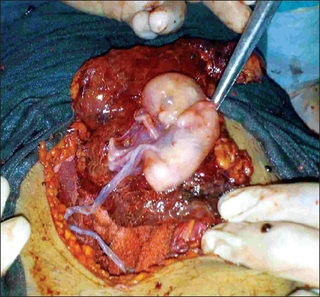Related Research Articles

Ectopic pregnancy is a complication of pregnancy in which the embryo attaches outside the uterus. Signs and symptoms classically include abdominal pain and vaginal bleeding, but fewer than 50 percent of affected women have both of these symptoms. The pain may be described as sharp, dull, or crampy. Pain may also spread to the shoulder if bleeding into the abdomen has occurred. Severe bleeding may result in a fast heart rate, fainting, or shock. With very rare exceptions the fetus is unable to survive.

Tubal ligation is a surgical procedure for female sterilization in which the fallopian tubes are permanently blocked, clipped or removed. This prevents the fertilization of eggs by sperm and thus the implantation of a fertilized egg. Tubal ligation is considered a permanent method of sterilization and birth control.

Miscarriage, also known in medical terms as a spontaneous abortion and pregnancy loss, is the death of an embryo or fetus before it is able to survive independently. Miscarriage before 6 weeks of gestation is defined by ESHRE as biochemical loss. Once ultrasound or histological evidence shows that a pregnancy has existed, the used term is clinical miscarriage, which can be early before 12 weeks and late between 12-21 weeks. Fetal death after 20 weeks of gestation is also known as a stillbirth. The most common symptom of a miscarriage is vaginal bleeding with or without pain. Sadness, anxiety, and guilt may occur afterwards. Tissue and clot-like material may leave the uterus and pass through and out of the vagina. Recurrent miscarriage may also be considered a form of infertility.
Gestational choriocarcinoma is a form of gestational trophoblastic neoplasia, which is a type of gestational trophoblastic disease (GTD), that can occur during pregnancy. It is a rare disease where the trophoblast, a layer of cells surrounding the blastocyst, undergoes abnormal developments, leading to trophoblastic tumors. The choriocarcinoma can metastasize to other organs, including the lungs, kidney, and liver. The amount and degree of choriocarcinoma spread to other parts of the body can vary greatly from person to person.

Salpingectomy refers to the surgical removal of a Fallopian tube. This may be done to treat an ectopic pregnancy or cancer, to prevent cancer, or as a form of contraception.

An abdominal pregnancy is a rare type of ectopic pregnancy where the embryo or fetus is growing and developing outside the womb in the abdomen, but not in the Fallopian tube, ovary or broad ligament.
Tubal reversal, also called tubal sterilization reversal, tubal ligation reversal, or microsurgical tubal reanastomosis, is a surgical procedure that can restore fertility to women after a tubal ligation. By rejoining the separated segments of the fallopian tube, tubal reversal can give women the chance to become pregnant again. In some cases, however, the separated segments cannot actually be reattached to each other. In some cases the remaining segment of tube needs to be re-implanted into the uterus. In other cases, when the end of the tube has been removed, a procedure called a neofimbrioplasty must be performed to recreate a functional end of the tube which can then act like the missing fimbria and retrieve the egg that has been released during ovulation.
Otto Spiegelberg was a German gynecologist. He was born in Peine and died in Breslau.

A heterotopic pregnancy is a complication of pregnancy in which both extrauterine (ectopic) pregnancy and intrauterine pregnancy occur simultaneously. It may also be referred to as a combined ectopic pregnancy, multiple‑sited pregnancy, or coincident pregnancy.

Ovarian torsion (OT) or adnexal torsion is an abnormal condition where an ovary twists on its attachment to other structures, such that blood flow is decreased. Symptoms typically include pelvic pain on one side. While classically the pain is sudden in onset, this is not always the case. Other symptoms may include nausea. Complications may include infection, bleeding, or infertility.

Chorionic hematoma is the pooling of blood (hematoma) between the chorion, a membrane surrounding the embryo, and the uterine wall. It occurs in about 3.1% of all pregnancies, it is the most common sonographic abnormality and the most common cause of first trimester bleeding.
The following outline is provided as an overview of and topical guide to obstetrics:
The Spiegelberg criteria are four criteria used to identify ovarian ectopic pregnancies named after Otto Spiegelberg.

An interstitial pregnancy is a uterine but ectopic pregnancy; the pregnancy is located outside the uterine cavity in that part of the fallopian tube that penetrates the muscular layer of the uterus. The term cornual pregnancy is sometimes used as a synonym, but remains ambiguous as it is also applied to indicate the presence of a pregnancy located within the cavity in one of the two upper "horns" of a bicornuate uterus. Interstitial pregnancies have a higher mortality than ectopics in general.

A cervical pregnancy is an ectopic pregnancy that has implanted in the uterine endocervix. Such a pregnancy typically aborts within the first trimester, however, if it is implanted closer to the uterine cavity – a so-called cervico-isthmic pregnancy – it may continue longer. Placental removal in a cervical pregnancy may result in major hemorrhage.
Theca lutein cyst is a type of bilateral functional ovarian cyst filled with clear, straw-colored fluid. These cysts result from exaggerated physiological stimulation due to elevated levels of beta-human chorionic gonadotropin (beta-hCG) or hypersensitivity to beta-hCG. On ultrasound and MRI, theca lutein cysts appear in multiples on ovaries that are enlarged.
Early pregnancy bleeding refers to vaginal bleeding before 14 weeks of gestational age. If the bleeding is significant, hemorrhagic shock may occur. Concern for shock is increased in those who have loss of consciousness, chest pain, shortness of breath, or shoulder pain.
Endometriosis and its complications are a major cause of female infertility. Endometriosis is a dysfunction characterized by the migration of endometrial tissue to areas outside of the endometrium of the uterus. The most common places to find stray tissue are on ovaries and fallopian tubes, followed by other organs in the lower abdominal cavity such as the bladder and intestines. Typically, the endometrial tissue adheres to the exteriors of the organs, and then creates attachments of scar tissue called adhesions that can join adjacent organs together. The endometrial tissue and the adhesions can block a fallopian tube and prevent the meeting of ovum and sperm cells, or otherwise interfere with fertilization, implantation and, rarely, the carrying of the fetus to term.

Catharine van Tussenbroek was a Dutch physician and feminist. She was the second woman to qualify as a physician in the Netherlands and the first physician to confirm evidence of the ovarian type of ectopic pregnancy. A foundation that administers research grants was set up in her name to continue her legacy of empowering women.

Prophylactic salpingectomy is a preventative surgical technique performed on patients who are at higher risk of having ovarian cancer, such as individuals who may have pathogenic variants of the BRCA1 or BRCA2 gene. Originally salpingectomy was used in cases of ectopic pregnancies. As a preventative surgery however, it involves the removal of the fallopian tubes. By not removing the ovaries this procedure is advantageous to individuals who are still of child bearing age. It also reduces risks such as cardiovascular disease and osteoporosis which are associated with removal of the ovaries.
References
Citations
- ↑ Lin, E. P.; Bhatt, S; Dogra, V. S. (2008). "Diagnostic clues to ectopic pregnancy". Radiographics. 28 (6): 1661–71. doi: 10.1148/rg.286085506 . PMID 18936028.
- 1 2 Speert, H. (1958). Otto Spiegelberg and His criteria of Ovarian Pregnancy, in Obstetric and Gynecologic Milestones. New York: MacMillan. p. 255ff.
- 1 2 3 4 5 6 7 8 Helde, M. D.; Campbell, J. S.; Himaya, A.; Nuyens, J. J.; Cowley, F. C.; Hurteau, G. D. (1972). "Detection of unsuspected ovarian pregnancy by wedge resection". The Canadian Medical Association Journal. 106 (3): 237–242. PMC 1940374 . PMID 5057958.
- 1 2 Ercal, T.; Cinar, O.; Mumcu, A.; Lacin, S.; Ozer, E. (1997). "Ovarian pregnancy: Relationship to an intrauterine device". Australian and New Zealand Journal of Obstetrics and Gynaecology. 37 (3): 362–364. doi:10.1111/j.1479-828x.1997.tb02434.x. PMID 9325530. S2CID 34369714.
- 1 2 3 4 Raziel, A.; Schachter, M.; Mordechai, E.; Friedler, S.; Panski, M.; Ron-El, R. (2004). "Ovarian pregnancy-a 12-year experience of 19 cases in one institution". European Journal of Obstetrics & Gynecology and Reproductive Biology. 114 (1): 92–96. doi:10.1016/j.ejogrb.2003.09.038. PMID 15099878.
- ↑ Priya, S.; Kamala, S.; Gunjan, S. (2009). "Two interesting cases of ovarian pregnancy after in vitro fertilization-embryo transfer and its successful laparoscopic management". Fertil. Steril. 92 (1): 394.e17–9. doi: 10.1016/j.fertnstert.2009.03.043 . PMID 19403128.
- 1 2 3 4 5 Odejinmi, F.; Rizzuto, M. I.; Macrae, R.; Olowu, O.; Hussain, M. (2009). "Diagnosis and laparoscopic management of 12 consecutive cases of ovarian pregnancy and review of literature". Journal of Minimally Invasive Gynecology. 16 (3): 354–359. doi:10.1016/j.jmig.2009.01.002. PMID 19423068.
- 1 2 3 4 5 Nwanodi, O.; Khulpateea, N. (2006). "The preoperative diagnosis of primary ovarian pregnancy". Journal of the National Medical Association. 98 (5): 796–798. PMC 2569290 . PMID 16749658.
- ↑ Manjula, N. V.; Sundar, G.; Shetty, S.; Sujani, B. K.; Mamatha. "A rare case of a ruptured ovarian pregnancy". Proceedings in Obstetrics and Gynecology.
- ↑ Habbu, J.; Read, M. D. (2006). "Ovarian pregnancy successfully treated with methotrexate". Journal of Obstetrics and Gynaecology. 26 (6): 587–588. doi:10.1080/01443610600831357. PMID 17000523. S2CID 23443252.
- ↑ Kudo, M.; Tanaka, T.; Fujimoto, S. (1988). "A successful treatment of left ovarian pregnancy with methotrexate". Nippon Sanka Fujinka Gakkai Zasshi. 40 (6): 811–813. PMID 2969025.
- 1 2 Thorek 1926, p. 106.
- ↑ Jacobson 1908, pp. 241–242.
- ↑ Jacobson 1908, pp. 242–243.
- ↑ Jacobson 1908, p. 243.
- ↑ Thorek 1926, p. 108.
- ↑ Jacobson 1908, p. 247.
- ↑ Jacobson 1908, p. 250.
- ↑ Jacobson 1908, pp. 258–262.
- ↑ Rizk 2010, p. 267.
- ↑ McDonald 1914, pp. 92–93.
- ↑ British Medical Journal 1900, p. 1442.
- 1 2 Ray 1921, p. 437.
Sources
- Jacobson, Sidney D. (1908). "True Primary Ovarian Pregnancy: Operation; Recovery". In Brooks, Henry T. (ed.). Contributions to the Science of Medicine and Surgery: In celebration of the twenty-fifth anniversary, 1882-1907, of the founding of the New York Post-Graduate Medical School and Hospital. New York: Jacobson New York Post-graduate Medical School and Hospital Faculty / Royal College of Physicians of Edinburgh.
- McDonald, Ellice (1914). Studies in gynecology and obstetrics. New York: American Medical Publishing Co. OCLC 11339026.
- Ray, Henry M. (June 1921). "Primary Ovarian and Primary Abdominal Pregnancy: Their Morphological Possibility". Surgery, Gynecology & Obstetrics. Chicago: Journal of the American College of Surgeons / Franklin H. Martin Memorial Foundation. 32. Retrieved 21 March 2016.
- Rizk, Botros R. M. B. (2010). Ultrasonography in Reproductive Medicine and Infertility. Cambridge, England: Cambridge University Press. ISBN 978-1-139-48457-2.
- Thorek, Max (February 1926). "Case of Ovarian Pregnancy with Histological Findings". The Illinois Medical Journal. Chicago: Illinois State Medical Society. 49: 106–111. Retrieved 6 April 2016.
- "Obstetrical Society of London". The British Medical Journal . London: Royal Medical and Chirurgical Society. 2 (2081): 1442. 17 November 1900. PMC 2463948 .